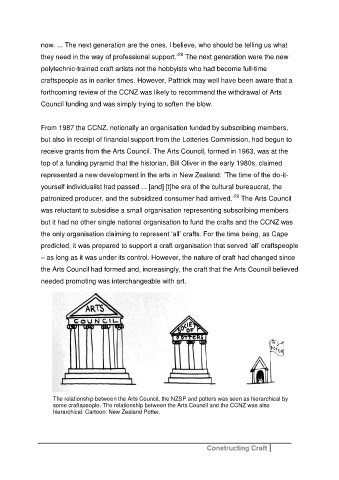Page 291 - Constructing Craft
P. 291
now. ... The next generation are the ones, I believe, who should be telling us what
28
they need in the way of professional support.’ The next generation were the new
polytechnic-trained craft artists not the hobbyists who had become full-time
craftspeople as in earlier times. However, Pattrick may well have been aware that a
forthcoming review of the CCNZ was likely to recommend the withdrawal of Arts
Council funding and was simply trying to soften the blow.
From 1987 the CCNZ, notionally an organisation funded by subscribing members,
but also in receipt of financial support from the Lotteries Commission, had begun to
receive grants from the Arts Council. The Arts Council, formed in 1963, was at the
top of a funding pyramid that the historian, Bill Oliver in the early 1980s, claimed
represented a new development in the arts in New Zealand: ‘The time of the do-it-
yourself individualist had passed ... [and] [t]he era of the cultural bureaucrat, the
29
patronized producer, and the subsidized consumer had arrived.’ The Arts Council
was reluctant to subsidise a small organisation representing subscribing members
but it had no other single national organisation to fund the crafts and the CCNZ was
the only organisation claiming to represent ‘all’ crafts. For the time being, as Cape
predicted, it was prepared to support a craft organisation that served ‘all’ craftspeople
– as long as it was under its control. However, the nature of craft had changed since
the Arts Council had formed and, increasingly, the craft that the Arts Council believed
needed promoting was interchangeable with art.
The relationship between the Arts Council, the NZSP and potters was seen as hierarchical by
some craftspeople. The relationship between the Arts Council and the CCNZ was also
hierarchical. Cartoon: New Zealand Potter.
Constructing Craft

